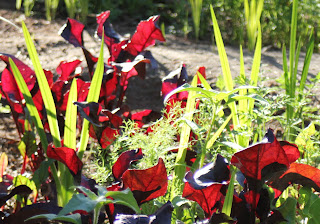This week it has been overcast. On this quiet and still winter (67 degrees) afternoon, walking through the farm gives one the sense of waiting. The crops aren't measurably bigger than last week. No sign, yet, of the seeds planted last week; kale, spinach, Chinese cabbage. I'm beginning to wonder if the spinach, planted in September and, according to the packet, due for harvest in November, will ever mature. Time seems suspended.
In the meantime, this week I made my first ever tomato sauce. The harvest from last week's pulling of the vines was many small tomatoes. First, I put them - whole - in the freezer, so that, upon thawing them, it was easy to remove the skins. They then sat in a colander overnight to seep out as much liquid as possible. Cooking them in a saucepot further broke down the pulp, but they still needed to be put through a strainer to separate out the solids (mostly the seeds). This was a lot of work, and took quite a long time. If I continue to do this, I will invest in a tomato mill!
 If the tomatoes had been larger, as I understand, you would peel and core them first, negating the strainer \ tomato mill step.
If the tomatoes had been larger, as I understand, you would peel and core them first, negating the strainer \ tomato mill step.
Back in the saucepan, I added onions which had been sauteed for 45 mins., to make them sweet, and some chicken stock, which had been conveniently also on the stove, and some dried basil. Very delicious and fresh tasting.
The tomatoes pictured made enough sauce for about 4 pasta dinners. We definitely need to plant more tomato plants!







